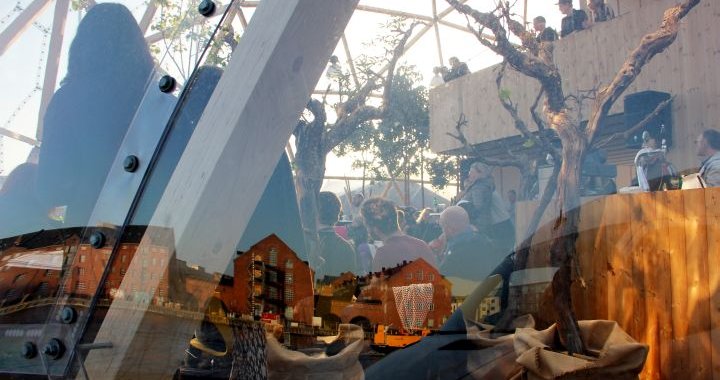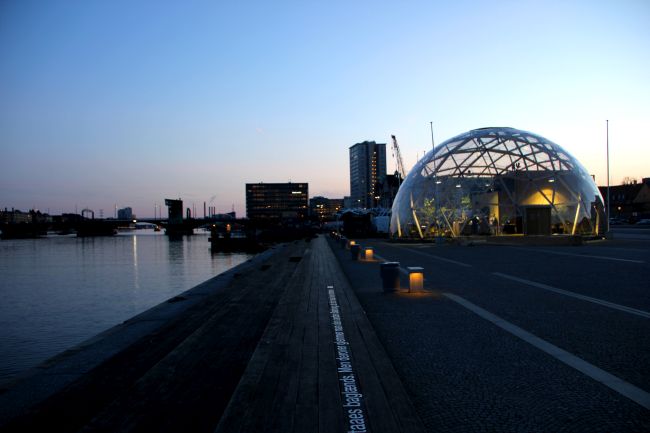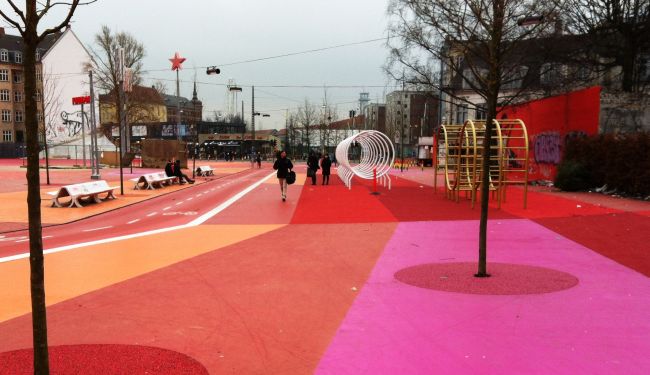
The Copenhagen Public Space Art Scene
Jacob Stubbe Østergaard
09/04/2014
When released from the confines of gallery rooms and pedestals and unleashed upon the public space, the artistic perspective can help widen a large number of people's everyday lives and open up new paths and new connections in individuals and in society. Public space art has been growing for a long time and it's still growing. Here's a glance at how the scene is developing in Copenhagen.
On April 1, the Dome of Visions opened in a central but largely overlooked square by the harbour in Copenhagen. Dome of Visions is a piece of temporary architecture. It is a house built inside a greenhouse. Because it's sheltered in a greenhouse, it doesn't require heating. It's built of cheap materials - mainly wood - because it does not need protection from the weather. Around the house in the middle of the dome, exotic plants grow high from the wooden floor. The plants are confusing: Are you indoors or outdoors?
During the coming year, this Dome of Visions is meant be a space for site specific culture and art events and debates and conferences about urban sustainability. At the same time, it will remain open to the public. The dome purports to be an experiment in city life - a part of the public space in a fuller way than regular indoors spaces separated from the city space by walls.
The Dome of Visions is architecture, culture, research, art and everyday life all rolled into one. In this fashion, it's a great example of the current development of art in the public space in Copenhagen and elsewhere.
"Art in the public space" used to mean sculptures in the middle of squares. Statues of kings, scenes from battles, religious motifs, that kind of thing. This kind of art reflected the values of the people in power and the size of the king's ego.

The Dome of Visions will play host to a series of performance and other art events curated by Gry Worre Hallberg of Fiction Pimps and Sisters Academy fame. Photo: NXT / DOME OF VISIONS
Of course there's been a development since then. In the late 20th century, "art in the public space" came to be associated with more abstract sculptures standing in the middle of roundabouts at the entrances to dull countryside towns that were all hopelessly attempting to set themselves apart from the rest by erecting the exact same sculpture in the middle of the exact same roundabout. This art may seem to be in the public space, but really it is in its own space, surrounded by the public space. It doesn't engage the public space. Although some of the "roundabout" artists may have considered the context of the circle of grass and the nondescript highway and the nondescript town, this art and the king's sculptures is all primarily symbolic. Instead of integrating, it invokes an alien context into the space where it's situated. It's a bit like a man standing by a government building, holding a sign with a political statement.
When we talk of "art in the public space" today, we are referring to art that actually engages its space, respects the characteristics of the space, challenges it, seeks to be an extension of it and to explore or even expand its properties. These abilities have brought art into the arms of architecture. Architecture has always embraced the symbolic version of public space art in the form of ornaments and decorations, but now it has teamed up with art in a common quest to create more fulfilling spaces and to open up the possibilities offered by said spaces.
This is the era of "relational aesthetics". In the words of Nicholas Bourriaud: "The role of artworks is no longer to form imaginary and utopian realities, but to actually be ways of living and models of action within the existing real, whatever scale chosen by the artist."
Art was invited into the public space at the downfall of modernist architecture. Modernist architecture can be viewed as a very large-scale experiment in putting everyday life on a formula. The formula went something like this:
"comfortable home + sunlight + efficient transportation to and from work + nearby entertainment facilities + well functioning public facilities = happiness".
Modernist architecture gave us these things but it turned out we need much more. We need to use the public space to shape our own worlds in our minds. We need to be different. We need a space where new ideas can grow. We need to be subjects. Art engages us as subjects. Art can create humane spaces where we can exercise our personalities.
In Copenhagen, this realization resulted in the commissioning of a large and highly active urban area to be re-designed by an architect group and an art collective working together on equal terms. This project would be known as SuperKilen. Work began in 2009 and ended in 2012. The area was split into zones named after colours (red, black, green...) and lots of creative elements were installed: boxing rings, swings, small artificial hills, fountains, stone furniture, a small playground shaped like an octopus. And then the masterstroke: the 57 various street furniture elements in the area came directly from each of the 57 nations represented by inhabitants in the local area.

The red part of Superkilen, next to the busy Nørrebrogade. Street furniture from at least seven different countries visible in this picture. Photo: Signe Als Nielsen
But rather than being a triumphant union of art, life and architecture employing art in its full potential as a means of enriching the everyday for almost everybody, SuperKilen ended up as a useful exhibition of the challenges to forming this elusive union. SuperKilen described itself as "a global exhibition in Nørrebro" - a phrase invoking the vocabulary of art as well as the relationship between the local and the global. However, "exhbition" is a traditional term which implies that there are objects to be displayed and an audience to witness them. In opposition to relational aesthetics, the idea of an exhibition imposes a separation between the exhibited objects and the world around them.
I wouldn't judge a whole concept by one word if it didn't describe the actual city space of SuperKilen so well. Just like the ancient statues of kings riding horses in the older parts of town, most of the 57 elements stand around like dreams of elsewhere, leaving the here lonely and unkempt. This problem has been addressed with the argument that "the site specific approach to public space art has been challenged by globalization". But isn't globalization merely another external context - like the old kings' wars - which one can impose on a space instead of letting it be shaped by the lives of the people living there?
To be fair, utilizing an artistic perspective to claim new territories of existence for everyone is extremely difficult in the context of major, permanent architectural schemes. The most successful attempts at using art in the public space in this fashion have been temporary. Temporary alterations of public spaces offer more possibilities because you don't have to worry about local plans, construction durability, traffic flow, building permits, standard measures, energy supply etc.
In 2006, the public art exhibition "SID NED!" ("SIT DOWN!") alighted on the then relatively unnoticed street of Mimersgade. The "exhibition" consisted of six independent works created by six different artists or artist collectives. Each of them was designed to recognize and challenge its spatial context. The project website states that the artworks were intended to "...challenge, in each their own way, Mimersgade's existence as an unnoticed street that one passes by on the way to better places." and that: "SID NED! is about the encounter with this place and the people living here. It's about challenging people's perception of a neighborhood. Those who live here as well as those who view it from outside."
The exhibition brought forth an artistically crafted shuttle bus taking people from one end of the street to the other and telling stories on the way, a flashy neon sign pointing to Mjølnerparken (an adjacent neighborhood slandered in the media for being a 'ghetto'), a video installation about neighborship featuring local inhabitants, a bunch of strangely shaped benches, and a social endeavour bringing together the aging and white guests of an old Danish worker's pub and the mainly young and middle-eastern pupils from the local school of commerce to plan and execute a renovation of the pub.

Pub guests and young immigrant students at Heimdal pub, SID NED 2006. Artist Kenneth Balfelt explores the socio-political side of public space art. Photo: Bureau Publik
In terms of public space, though, the most interesting project took the shape of a small hilly landscape on a lawn next to Mimersgade. Here, the art collective "Parfyme" adopted the role of a team of builders, building street furniture every day from 9 to 5 and talking to passers-by about what they should build for the place. This dialogue with passers-by was a miniature version of the token "dialogue with the residents" which is a requirement at any major permanent city development project. "Dialogue" in that case usually means residents ask a lot of questions and voice a lot of suggestions and complaints, after which a few insignificant and pre-planned concessions are made and the development continues according to the interests of the investors. The "Hilly landscape" created by Parfyme offered spatial improvements not only corresponding to the wishes of locals but also able to respond to their wishes changing from day to day. The project was also a study in residents seizing ownership of a city space they might previously have been indifferent to. Parfyme reports: "At the end of one of our working days, we were surveying our works from a distance when this teenage boy passed by. Completely out of the blue, he knocked over this stand that we had just finished. But then a group of 20 or so younger kids who were playing on the hills went and raised the stand again through a cooperative effort.".

Hilly landscape and building site, SID NED 2006
In the following years, Mimersgade and the surrounding neighbourhood gradually abandoned its unnoticed existence and turned into a stronghold of grassroots art initiatives. Others factors may also have influenced this development, but it's not unlikely that the temporary "SID NED!" exhibition helped cause long-lasting positive changes to the area by exploring its potential.
According to the curator of "SID NED!", Christian Skovbjerg Jensen: "Using art in city development is about translating the analyses that art makes of cities, people and possibilities in our lives into something concrete and constructive. We are still generally not good enough at this."
But at least we're trying. Christian Skovbjerg Jensen himself is currently setting up the organization "SOMEWHERE", which seeks to help professionalize public space art and help it grow. "It will be like an art venue without a building. The public space is the venue.", Skovbjerg Jensen explains. "...Attention to this field of art has been steadily growing for 10 or 15 years. Media and politicians have become more and more interested. But organizationally, not much has happened. We have gathered a lot of experience but we need more professionalization."
In the city of Køge south of Copenhagen lies the only museum dedicated to art in the public space. Museum director Christine Buhl Andersen explains the appeal of this kind of art:
"Many artists today are happy to work in the public space, preferably through temporary interventions, free of the controlling influence of institutions and explanatory plaques, in a direct exchange with their audience. There have been countless instances where artists have affected the architecture or configured the concept of 'design'. The influencing goes both ways, but art is good at posing questions and opening people's eyes to a different view on things."
Back in the middle of the medieval city centre of Copenhagen, the Dome of Visions stands like a big mushroom grown up from the stony soil of the city. Its considerable size seems to parallel the growth in prominence of the integrated artistic/architectural/political concept it represents.